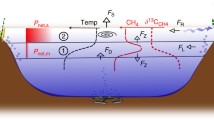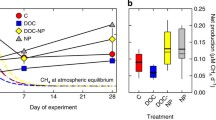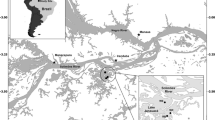Abstract
Understanding the drivers of aerobic methane (CH4) oxidation (MOX) is paramount in assessing the current and potential future CH4 emissions from freshwater aquatic systems. Regulation of MOX kinetics is a complex function of CH4 and oxygen (O2) concentrations. While MOX activity is usually proportional to the concentration of CH4 itself, the effects of O2 have been more conflicting, with maximum MOX rates often restricted to low O2 concentrations. Despite the complexity involved, MOX kinetics are often modelled as monotonic positive functions of both CH4 and O2 concentrations. We conducted a series of incubation experiments using natural and unamended water samples obtained from multiple depths in northern temperate lakes that vary widely and independently in their CH4 and O2 concentrations. Our results showed the expected positive effect of CH4 concentration and temperature but also demonstrated the strong inhibitory effects of O2 at high concentration. We then developed a general model describing the kinetics of MOX, simultaneously integrating the effects of CH4 concentration, temperature as well as the non-linear effect O2 on MOX activity. The model revealed an overall temperature dependency (activation energy = 0.49 ± 0.06 eV) much lower than reported for methanogenesis and an optimal O2 level around 15 μmol O2 L−1 where maximum MOX activity occurs, regardless of CH4 concentration and temperature. We further show that ignoring the inhibitory effect of O2 can lead to significant bias in calculating the expected MOX rates in different portions of the water column.




Similar content being viewed by others
References
Barbosa PM, Farjalla VF, Melack JM, Amaral JHF, da Silva JS, Forsberg BR (2018) High rates of methane oxidation in an Amazon floodplain lake. Biogeochemistry 137(3):351–365
Bastviken D (2009) Methane. In: Likens GE (ed) Encyclopedia of inland waters. Elsevier, New York, pp 783–805
Bastviken D, Cole J, Pace M, Tranvik L (2004) Methane emissions from lakes: dependence of lake characteristics, two regional assessments, and a global estimate. Global Biogeochem Cycles 18(4)
Bastviken D, Cole JJ, Pace ML, Van de Bogert MC (2008) Fates of methane from different lake habitats: connecting whole-lake budgets and CH4 emissions. J Geophys Res 113(G2)
Blees J, Niemann H, Wenk CB, Zopfi J, Schubert CJ, Kirf MK et al (2014a) Micro-aerobic bacterial methane oxidation in the chemocline and anoxic water column of deep south-Alpine Lake Lugano (Switzerland). Limnol Oceanogr 59(2):311–324
Blees J, Niemann H, Wenk CB, Zopfi J, Schubert CJ, Jenzer JS et al (2014b) Bacterial methanotrophs drive the formation of a seasonal anoxic benthic nepheloid layer in an alpine lake. Limnol Oceanogr 59(4):1410–1420
Carini S, Bano N, LeCleir G, Joye SB (2005) Aerobic methane oxidation and methanotroph community composition during seasonal stratification in Mono Lake, California (USA). Environ Microbiol 7(8):1127–1138
Coleman DD, Risatti JB, Schoell M (1981) Fractionation of carbon and hydrogen isotopes by methane-oxidizing bacteria. Geochim Cosmochim Acta 45(7):1033–1037
Conrad R (1996) Soil microorganisms as controllers of atmospheric trace gases (H2, CO, CH4, OCS, N2O, and NO). Microbiol Rev 60(4):609–640
Deshmukh C, Guérin F, Labat D, Pighini S, Vongkhamsao A, Guédant P et al (2016) Low methane (CH4) emissions downstream of a monomictic subtropical hydroelectric reservoir (Nam Theun 2, Lao PDR). Biogeosciences 13(6):1919–1932
Duc NT, Crill P, Bastviken D (2010) Implications of temperature and sediment characteristics on methane formation and oxidation in lake sediments. Biogeochemistry 100(1–3):185–196
Dunfield P, Dumont R, Moore TR (1993) Methane production and consumption in temperate and subarctic peat soils: response to temperature and pH. Soil Biol Biochem 25(3):321–326
Frenzel P, Thebrath B, Conrad R (1990) Oxidation of methane in the oxic surface layer of a deep lake sediment (Lake Constance). FEMS Microbiol Ecol 6(2):149–158
Fuchs A, Lyautey E, Montuelle B, Casper P (2016) Effects of increasing temperatures on methane concentrations and methanogenesis during experimental incubation of sediments from oligotrophic and mesotrophic lakes. J Geophys Res 121(5):1394–1406
Guérin F, Abril G (2007) Significance of pelagic aerobic methane oxidation in the methane and carbon budget of a tropical reservoir. J Geophys Res 112(G3)
Hanson RS, Hanson TE (1996) Methanotrophic bacteria. Microbiol Rev 60(2):439–471
Houser JN, Bade DL, Cole JJ, Pace ML (2003) The dual influences of dissolved organic carbon on hypolimnetic metabolism: organic substrate and photosynthetic reduction. Biogeochemistry 64(2):247–269
Itoh M, Kobayashi Y, Chen TY, Tokida T, Fukui M, Kojima H, Okuda N (2015) Effect of interannual variation in winter vertical mixing on CH4 dynamics in a subtropical reservoir. J Geophys Res 120(7):1246–1261
Jansson M, Karlsson J, Jonsson A (2012) Carbon dioxide supersaturation promotes primary production in lakes. Ecol Lett 15(6):527–532
Kankaala P, Huotari J, Peltomaa E, Saloranta T, Ojala A (2006) Methanotrophic activity in relation to methane efflux and total heterotrophic bacterial production in a stratified, humic, boreal lake. Limnol Oceanogr 51(2):1195–1204
Kankaala P, Taipale S, Nykänen H, Jones RI (2007) Oxidation, efflux, and isotopic fractionation of methane during autumnal turnover in a polyhumic, boreal lake. J Geophys Res 112(G2)
Kankaala P, Bellido JL, Ojala A, Tulonen T, Jones RI (2013) Variable production by different pelagic energy mobilizers in boreal lakes. Ecosystems 16(6):1152–1164
Knoblauch C, Zimmermann U, Blumenberg M, Michaelis W, Pfeiffer EM (2008) Methane turnover and temperature response of methane-oxidizing bacteria in permafrost-affected soils of northeast Siberia. Soil Biol Biochem 40(12):3004–3013
Lofton DD, Whalen SC, Hershey AE (2014) Effect of temperature on methane dynamics and evaluation of methane oxidation kinetics in shallow Arctic Alaskan lakes. Hydrobiologia 721(1):209–222
Marchand D, Prairie YT, del Giorgio PA (2009) Linking forest fires to lake metabolism and carbon dioxide emissions in the boreal region of Northern Quebec. Glob Change Biol 15(12):2861–2873
Martinez-Cruz K, Sepulveda-Jauregui A, Walter Anthony K, Thalasso F (2015) Geographic and seasonal variation of dissolved methane and aerobic methane oxidation in Alaskan lakes. Biogeosciences 12(15):4595–4606
Michaud AB, Dore JE, Achberger AM, Christner BC, Mitchell AC, Skidmore ML, Vick-Majors TJ, Priscu JC (2017) Microbial oxidation as a methane sink beneath the West Antarctic Ice Sheet. Nat Geosci 10:582–586
Michmerhuizen CM, Striegl RG, McDonald ME (1996) Potential methane emission from north-temperate lakes following ice melt. Limnol Oceanogr 41(5):985–991
Milucka J, Kirf M, Lu L, Krupke A, Lam P, Littmann S et al (2015) Methane oxidation coupled to oxygenic photosynthesis in anoxic waters. ISME J 9:1991–2002
Morana C, Borges AV, Roland FAE, Darchambeau F, Descy JP, Bouillon S (2015) Methanotrophy within the water column of a large meromictic tropical lake (Lake Kivu, East Africa). Biogeosciences 12(7):2077–2088
Müller B, Bryant LD, Matzinger A, Wüest A (2012) Hypolimnetic oxygen depletion in eutrophic lakes. Environ Sci Technol 46(18):9964–9971
Natchimuthu S, Sundgren I, Gålfalk M, Klemedtsson L, Crill P, Danielsson Å, Bastviken D (2016) Spatio-temporal variability of lake CH4 fluxes and its influence on annual whole lake emission estimates. Limnol Oceanogr 61:S13–S26
Oswald K, Milucka J, Brand A, Littmann S, Wehrli B, Kuypers MM, Schubert CJ (2015) Light-dependent aerobic methane oxidation reduces methane emissions from seasonally stratified lakes. PLoS One 10(7):e0132574
Oswald K, Jegge C, Tischer J, Berg J, Brand A, Miracle MR et al (2016) Methanotrophy under versatile conditions in the water column of the ferruginous meromictic Lake La Cruz (Spain). Front Microbiol 7:1762
Rasilo T, Prairie YT, Giorgio PA (2015) Large-scale patterns in summer diffusive CH4 fluxes across boreal lakes, and contribution to diffusive C emissions. Glob Chang Biol 21(3):1124–1139
Riera JL, Schindler JE, Kratz TK (1999) Seasonal dynamics of carbon dioxide and methane in two clear-water lakes and two bog lakes in northern Wisconsin, USA. Can J Fish Aquat Sci 56(2):265–274
Roland FA, Morana C, Darchambeau F, Crowe SA, Thamdrup B, Descy JP, Borges AV (2018) Anaerobic methane oxidation and aerobic methane production in an east African great lake (Lake Kivu). J Great Lakes Res 44:1183–1193
Rudd JWM, Hamilton RD (1975) Factors controlling rates of methane oxidation and the distribution of the methane oxidizers in a small stratified lake. Arch Hydrobiol 75:522–538
Rudd JW, Hamilton RD, Campbell NER (1974) Measurement of microbial oxidation of methane in lake water. Limnol Oceangr 19(3):519–524
Rudd JW, Furutani A, Flett RJ, Hamilton RD (1976) Factors controlling methane oxidation in shield lakes: the role of nitrogen fixation and oxygen concentration. Limnol Oceanogr 21(3):357–364
Sawakuchi HO, Bastviken D, Sawakuchi AO, Ward ND, Borges CD, Tsai SM et al (2016) Oxidative mitigation of aquatic methane emissions in large Amazonian rivers. Glob Chang Biol 22(3):1075–1085
Schindler DW (1977) Evolution of phosphorus limitation in lakes. Science 195:260–262
Schubert CJ, Lucas FS, Durisch-Kaiser E, Stierli R, Diem T, Scheidegger O, Vazquez F, Müller B (2010) Oxidation and emission of methane in a monomictic lake (Rotsee, Switzerland). Aquat Sci 72(4):455–466
Schubert CJ, Vazquez F, Lösekann-Behrens T, Knittel K, Tonolla M, Boetius A (2011) Evidence for anaerobic oxidation of methane in sediments of a freshwater system (Lago di Cadagno). FEMS Microbiol Ecol 76(1):26–38
Segers R (1998) Methane production and methane consumption: a review of processes underlying wetland methane fluxes. Biogeochemistry 41(1):23–51
Shapiro J (1988) Introductory lecture at the international symposium ‘Phosphorus in Freshwater Ecosystems’, Uppsala, Sweden, in October 1985. Hydrobiologia 170:9–17
Shelley F, Abdullahi F, Grey J, Trimmer M (2015) Microbial methane cycling in the bed of a chalk river: oxidation has the potential to match methanogenesis enhanced by warming. Freshw Biol 60(1):150–160
Shelley F, Ings N, Hildrew AG, Trimmer M, Grey J (2017) Bringing methanotrophy in rivers out of the shadows. Limnol Oceanogr 62(6):2345–2359
Sivan O, Adler M, Pearson A, Gelman F, Bar-Or I, John SG, Eckert W (2011) Geochemical evidence for iron-mediated anaerobic oxidation of methane. Limnol Oceanogr 56(4):1536–1544
Sturm A, Fowle DA, Jones C, Leslie K, Nomosatryo S, Henny C, Canfield DE, Crowe SA (2019) Rates and pathways of CH4 oxidation in ferruginous Lake Matano. Geobiology (in press), Indonesia
Templeton AS, Chu KH, Alvarez-Cohen L, Conrad ME (2006) Variable carbon isotope fractionation expressed by aerobic CH 4-oxidizing bacteria. Geochim Cosmochim Acta 70(7):1739–1752
Thottathil SD, Reis PCJ, del Giorgio PA, Prairie YT (2018) The extent and regulation of summer methane oxidation in northern lakes. J Geophys Res 123:3216–3230
Uhlig C, Loose B (2017) Using stable isotopes and gas concentrations for independent constraints on microbial methane oxidation at Arctic Ocean temperatures. Limnol Oceanogr Methods 15(8):737–751
Wang C, Xiao S, Li Y, Zhong H, Li X, Peng F (2014) Methane formation and consumption processes in Xiangxi Bay of the Three Gorges Reservoir. Sci Rep 24(4):4449
Whiticar MJ (1999) Carbon and hydrogen isotope systematics of bacterial formation and oxidation of methane. Chem Geol 161(1):291–314
Yamamoto S, Alcauskas JB, Crozier TE (1976) Solubility of methane in distilled water and seawater. J Chem Eng Data 21(1):78–80
Yvon-Durocher G, Allen AP, Bastviken D, Conrad R, Gudasz C, St-Pierre A et al (2014) Methane fluxes show consistent temperature dependence across microbial to ecosystem scales. Nature 507(7493):488–491
Zigah PK, Oswald K, Brand A, Dinkel C, Wehrli B, Schubert CJ (2015) Methane oxidation pathways and associated methanotrophic communities in the water column of a tropical lake. Limnol Oceanogr 60(2):553–572
Acknowledgements
We thank Brenden Chabot and Katherine Velghe for assistance in the field and laboratory. We also thank the staff at the Station de biologie des Laurentides (Université de Montréal) for assistance. This study was supported by Natural Sciences and Engineering Research Council of Canada Discovery grants to YTP and is a contribution to UNESCO Chair in Global Environmental Change. SDT and PCJR are supported by doctoral scholarships from Fonds de recherche Nature et Technologies du Québec.
Author information
Authors and Affiliations
Corresponding author
Additional information
Publisher's Note
Springer Nature remains neutral with regard to jurisdictional claims in published maps and institutional affiliations.
Responsible Editor: J. M. Melack.
Electronic supplementary material
Below is the link to the electronic supplementary material.
Rights and permissions
About this article
Cite this article
Thottathil, S.D., Reis, P.C.J. & Prairie, Y.T. Methane oxidation kinetics in northern freshwater lakes. Biogeochemistry 143, 105–116 (2019). https://doi.org/10.1007/s10533-019-00552-x
Received:
Accepted:
Published:
Issue Date:
DOI: https://doi.org/10.1007/s10533-019-00552-x




